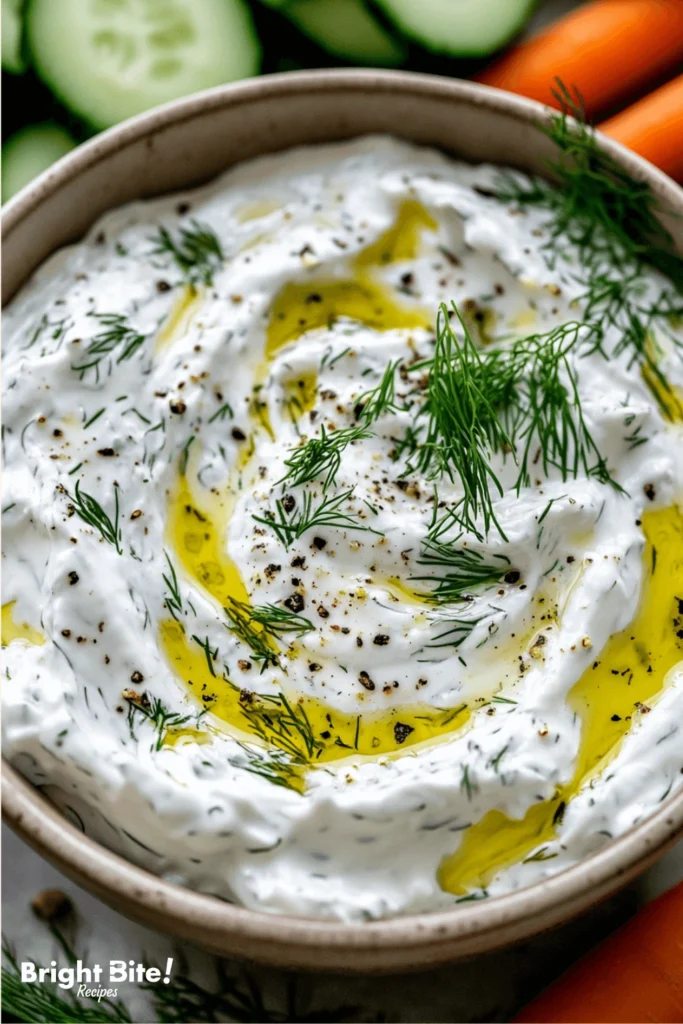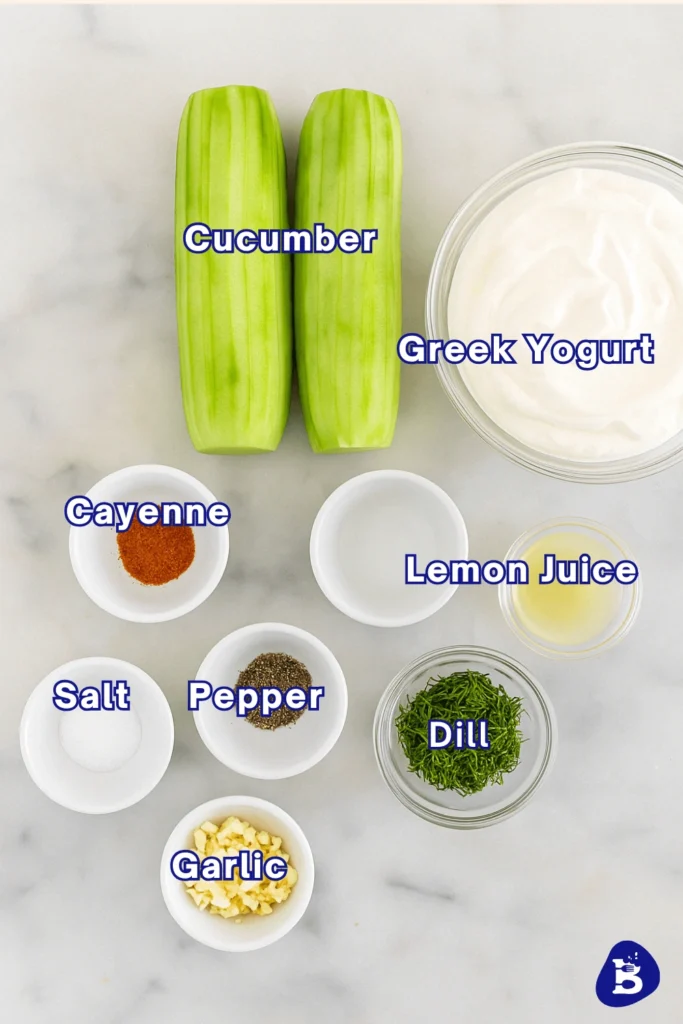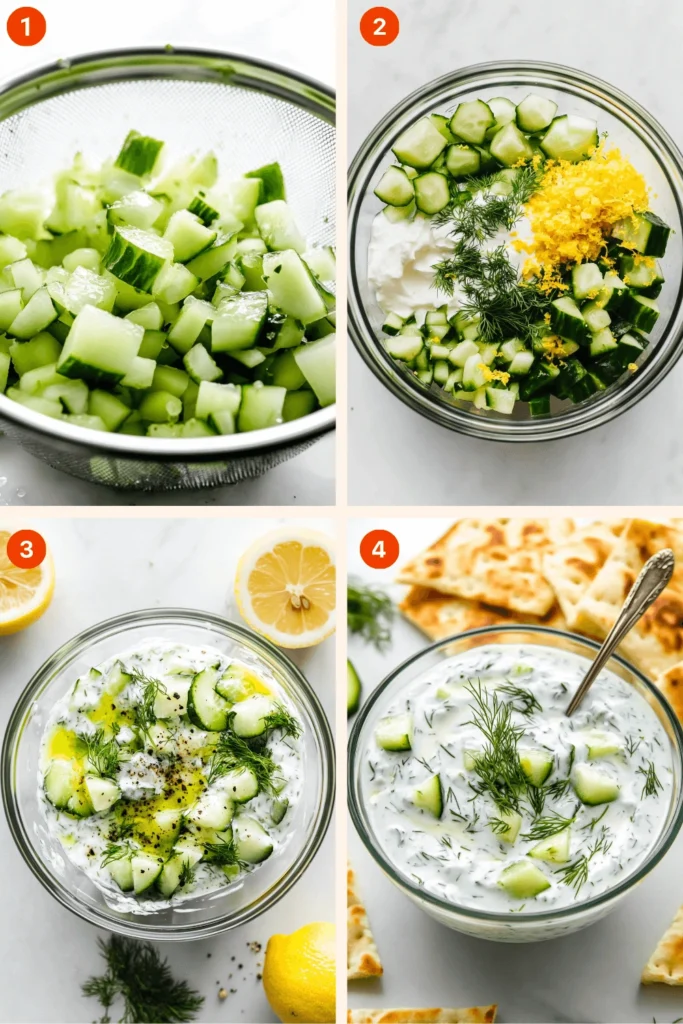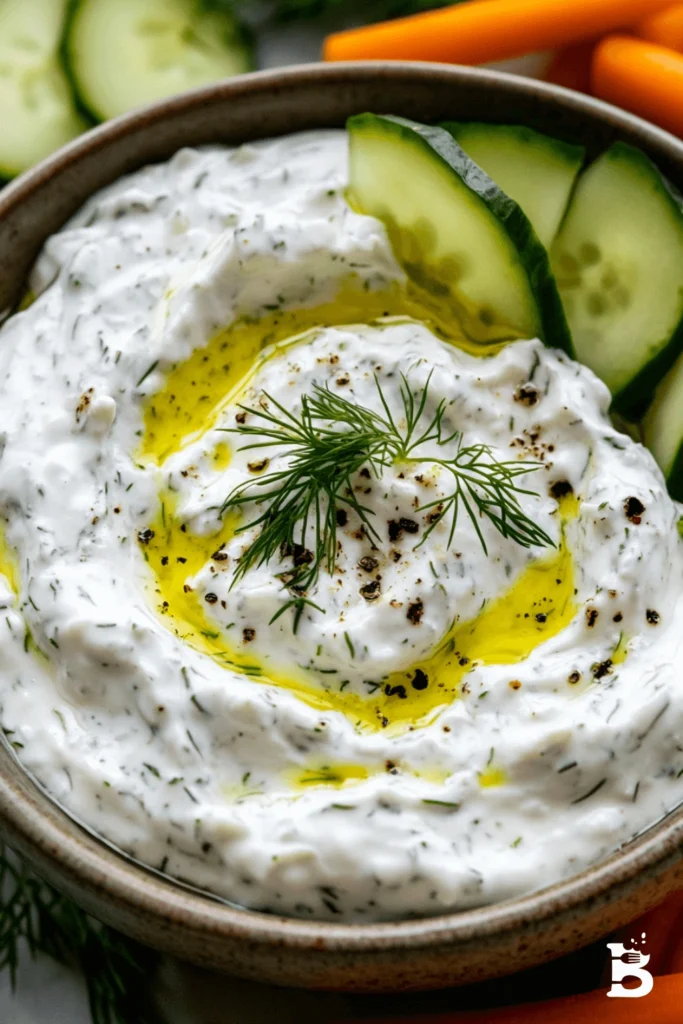Tzatziki Sauce is a surprisingly simple recipe that feels fancy once it hits your plate. Cool, creamy, and packed with fresh flavors, it brings a fresh burst of brightness to just about anything you pair it with. Whether you’ve had it drizzled over grilled meats or tucked inside a warm pita, chances are you’ve already tasted this Mediterranean gem and loved it—maybe without even knowing what it’s called.
At its core, Tzatziki Sauce is a blend of thick yogurt, cucumber, garlic, and herbs. But beyond those basics, there’s a lot of flexibility to make it your own. What’s great about this sauce is how it hits that sweet spot between rich and refreshing. It’s satisfying, but it doesn’t weigh you down. And even though it’s traditionally Greek, its appeal spans various cuisines and meals.
This guide will explain everything you need to know to make the best Tzatziki Sauce at home. From tips on choosing the right yogurt to fun variations and creative ways to serve it, we’ve got you covered. And the best part? You don’t need fancy ingredients or tools to remove it—just a few fridge staples and a grater.

Table of Contents
Why You’ll Love This Recipe
There’s a reason Tzatziki Sauce shows up at so many Mediterranean tables. It checks all the right boxes. Here’s what makes it such a favorite:
- It’s fast and easy to make. You can whip it up in about 15 minutes, from start to finish.
- Minimal ingredients, maximum flavor. A handful of pantry and fridge staples combine to create something more than the sum of its parts.
- It’s naturally healthy. With Greek yogurt as its base, it’s packed with protein and probiotics and fits into many dietary lifestyles—keto, Mediterranean, gluten-free, and vegetarian.
- It’s super versatile. Use it as a dip, spread, drizzle, or marinade. It plays well with meat, veggies, grains, and more.
- It’s make-ahead friendly. The flavors improve with time, so it’s perfect for meal prep or party planning.
Whether serving it alongside grilled chicken, spooning it over falafel, or dipping veggies into it for a quick snack, it adds an instant upgrade to any dish.
Detailed Ingredients and Instructions for the Tzatziki Sauce
Let’s break down what goes into making authentic Tzatziki Sauce and, more importantly, how to get it just right.

- Yogurt: This is the base of the sauce, so it matters. Full-fat Greek yogurt is the traditional pick—thick, creamy, and tangy. If you use plain yogurt, strain it first to get that thick texture. The richer the yogurt, the smoother and more indulgent the final result.
- Cucumber: You want a firm and crisp cucumber, like an English cucumber or Persian cucumber. Peel it, grate it, and—this is key—squeeze out as much moisture as possible. Too much water, and you’ll end up with a runny sauce. A cheesecloth or clean kitchen towel works best for this step.
- Garlic: One clove adds a nice sharp kick without overpowering the sauce. If you like it bold, add a second clove. Grating or pressing the garlic makes sure it blends evenly and doesn’t leave any raw chunks behind.
- Lemon Juice or Vinegar: This gives the sauce brightness and balances the richness of the yogurt. Lemon juice adds a fresher citrus note, while white or red wine vinegar gives it a punchier edge. Either work—use what you like.
- Olive Oil: Just a drizzle adds some depth and smoothness. It also helps bind the flavors together.
- Fresh Herbs: Dill is the classic choice, but mint, parsley, or even chives can add a twist. Go with fresh herbs for the best flavor, and chop them fine so they don’t clump.
- Salt and Pepper: Season to taste. Salt helps bring out the flavors of the cucumber and garlic, and a bit of black pepper rounds everything out.
Once you’ve prepped all the ingredients, the process is super straightforward:
- Grate and strain the cucumber until most of the water is gone.
- Stir it into the yogurt with garlic, lemon juice or vinegar, olive oil, herbs, salt, and pepper.
- Let it chill in the fridge for at least 30 minutes. This step lets the flavors meld and gives the sauce its signature coolness.

It’s one of those recipes where the extra wait is worth it.
Tips, Variations, and Storage Options
Tips for Making It Just Right
Even though Tzatziki Sauce is simple to prepare, a few minor adjustments can take it from good to seriously great. Here’s what to keep in mind:
- Drain that cucumber. This step makes or breaks your texture. If there’s too much water left in the cucumber, the sauce turns runny quickly. Squeeze hard—like really wring it out. You’ll thank yourself later.
- Let it rest. After mixing, give the sauce at least half an hour in the fridge. This isn’t just about temperature. The garlic mellows, the herbs infuse, and the yogurt pick up all the good stuff.
- Taste and tweak. Everyone’s garlic tolerance is different. The same goes for salt and lemon. Always taste before serving and adjust as needed. You want balance—creamy, tangy, and just the right punch from the garlic.
- Use full-fat yogurt if you can. Lower-fat yogurts can still work, but the texture and richness shine with the full-fat stuff. And because you’re eating it in small amounts, it’s worth the upgrade.
Fun Variations to Try
The beauty of Tzatziki Sauce is its flexibility. Once you’ve got the classic down, try mixing things up with these twists:
- Add some spice. A pinch of cayenne or a splash of hot sauce can give it a little kick without losing that creamy base.
- Try roasted garlic. Swapping raw garlic for roasted gives a sweeter, more mellow flavor—perfect if raw garlic tends to be too strong for you.
- Switch up the herbs. Fresh dill is classic, but mint adds coolness, basil brings sweetness, and cilantro gives a more global twist.
- Use lime instead of lemon. Especially if you pair it with tacos, grilled shrimp, or spicy foods, lime gives it a different citrus brightness.
- Add grated onion. For extra sharpness and depth, grate a bit of sweet or red onion into the mix—just like with the cucumber, and squeeze out the liquid first.
- Make it vegan. Use a plant-based Greek-style yogurt (unsweetened, of course), and you’ve got a vegan version that’s still creamy and flavorful.
Storage Tips
Tzatziki Sauce improves with some rest, making it perfect for prepping.
- Fridge: Store it in an airtight container in the fridge. It’ll stay good for around 4 to 5 days. Stir before each use since it may separate slightly over time.
- Freezer: It’s not ideal for freezing. The texture gets watery when thawed because of the cucumber and yogurt combo. If you must, strain well before freezing and expect a less smooth texture when defrosted.
- Meal prep: It’s great for portioning into small containers for lunch prep. Add to wraps, bowls, or salads before eating to keep things fresh.
Equipment Needed
You don’t need a fully stocked kitchen to make great Tzatziki Sauce. A few basic tools are all it takes.
- Box Grater or Microplane: Essential for grating cucumber and garlic. You want fine shreds so they blend into the yogurt smoothly.
- Mixing Bowl: A medium-sized one works best for combining everything.
- Cheesecloth or Clean Kitchen Towel: This squeezes out the excess water from the cucumber. This step is crucial for the right texture.
- Fine Mesh Strainer (optional): This is helpful if you’re straining regular yogurt to thicken it. Greek yogurt usually doesn’t need this step.
- Spoon or Spatula: Mix the ingredients evenly.
That’s it. No fancy gadgets, no blender, no food processor. Just basic, everyday tools and a little bit of patience.
Related Recipes
If you’re into Tzatziki Sauce, chances are you’ll enjoy these other Mediterranean-inspired dishes that complement or feature it:
- Greek Chicken Salad: Fresh, hearty, and packed with bold Mediterranean flavors. Juicy grilled chicken, crisp veggies, and briny olives come together with a tangy dressing—and yes, it’s made to be paired with tzatziki.
- Greek Chicken Souvlaki: Tender marinated chicken skewers grilled to perfection. Tzatziki is the ultimate sauce to drizzle over the top or dip them in.
- Falafel Wraps: Crispy chickpea fritters wrapped in flatbread with veggies and tzatziki make for a satisfying plant-based meal.
- Mediterranean Grain Bowl: Quinoa or couscous topped with roasted veggies, olives, feta, and a big dollop of tzatziki for a creamy balance.
- Lamb Gyros: Slow-cooked lamb stuffed into a warm pita with onion, tomato, and—you guessed it—tzatziki.
These dishes make the most of tzatziki’s creamy, tangy flavor, whether as a dip, sauce, or sandwich spread. Once you’ve made a batch, building a whole meal around it is easy.
Pairing/Serving Suggestions
Tzatziki Sauce is incredibly versatile, which is one of the reasons people keep it on repeat in their kitchens. It works across meals, from breakfast to dinner, and plays well with various cuisines, not just Greek or Mediterranean. Below are some best ways to pair and serve it, whether building a whole dish around it or just looking to use up an extra batch.
Classic Mediterranean Pairings
- Grilled meats: Chicken, lamb, beef—pretty much any grilled protein gets better with a spoonful of tzatziki. Think skewers, kebabs, and chops.
- Pita and veggies: One of the most common and beloved combos is simple—just warm pita wedges and fresh-cut cucumber, carrots, or bell peppers for dipping.
- Gyros or wraps: Fold it into flatbread with sliced meat, onion, and tomato for a quick and flavorful meal.
- Falafel: The cooling quality of tzatziki perfectly balances the crispy, spiced exterior of falafel balls or patties.
Unexpected (but amazing) Pairings
- Roasted potatoes: Swap sour cream and use tzatziki as a dip for crispy roasted potatoes. It’s tangy and refreshing against the caramelized, earthy flavors.
- Burgers and sandwiches: Use tzatziki instead of mayo on burgers or sandwiches for a lighter, more herbaceous twist.
- Tacos: Especially fish or shrimp tacos. The cucumber and yogurt provide a contrast to spicy, smoky flavors.
- Grain bowls: Whether working with brown rice, farro, or bulgur, tzatziki can tie the whole bowl together with its creamy zing.
- Egg dishes: Drizzle over scrambled eggs or a veggie-packed omelet for something different in your brunch rotation.
How to Serve It
- As a dip: Serve chilled in a bowl with olive oil drizzled on top. Sprinkle with a pinch of extra herbs or sumac if you want to dress it up.
- As a drizzle: Thin it with a tiny bit of water or lemon juice and drizzle it over bowls, grilled vegetables, or meats.
- As a spread: Smear it on sandwiches, toast, or flatbreads to instantly elevate your bite.
- As a sauce base: Use it as a creamy layer underneath roasted veggies or grilled proteins to anchor your plate.
The possibilities are endless. Once you start using tzatziki this way, it becomes your secret weapon in the kitchen.

Frequently Asked Questions
Is tzatziki the same as cucumber yogurt dip?
Pretty much! Different cultures have their versions of yogurt and cucumber-based dips. What makes tzatziki distinct is garlic, olive oil, lemon juice, vinegar, and usually fresh dill. So while similar, tzatziki has a specific balance of flavors that set it apart.
Can I make tzatziki without Greek yogurt?
Yes, but you’ll need to strain regular plain yogurt to get that thick, creamy consistency. Let it sit in a cheesecloth over a bowl for a few hours or overnight in the fridge. You’ll end up with something very close to Greek yogurt in texture.
Is tzatziki sauce supposed to be runny or thick?
It should be thick enough to hold its shape on a spoon but soft enough to scoop or spread easily. If it’s too runny, it probably needs more straining—either the cucumber wasn’t drained well enough or the yogurt needs thickening.
How long does homemade tzatziki last?
Appropriately stored in the fridge, it’ll last about 4 to 5 days. Just stir it before each use. If it starts to smell off or separate too much, it’s time to toss it.
Can I freeze tzatziki?
Technically, yes—but it’s not ideal. The texture can become grainy or watery after thawing. If you freeze it, ensure it’s well strained beforehand and know that you might need to stir or blend it again once defrosted.
Is tzatziki healthy?
Yes, especially if made with full-fat or low-fat Greek yogurt. It’s rich in protein, calcium, and probiotics while relatively low in calories. Just watch the portion size if you’re keeping an eye on sodium or fat content.
Does tzatziki taste better the next day?
It absolutely can. Letting it chill for several hours (or overnight) gives the garlic time to mellow and the herbs time to infuse, making everything taste more balanced and flavorful.
Nutrition Information
While exact numbers can vary based on ingredients and quantities, here’s an average breakdown per serving (about two tablespoons):
- Calories: Around eighty
- Protein: Three grams
- Carbohydrates: Two grams
- Fat: Six grams
- Fiber: Less than one gram
- Sugar: One to two grams (naturally from dairy and cucumber)
Most calories come from olive oil and yogurt, but thanks to the fresh ingredients and low carb count, they fit well into many diets.
It’s also naturally gluten-free and can be made dairy-free with plant-based yogurt alternatives. This makes it an excellent option for parties or potlucks when unsure about everyone’s dietary needs.
Seasonal and Occasion Variations
One of the best parts of making your Tzatziki Sauce is how easy it is to tailor it for different seasons, holidays, or occasions. The basic recipe stays the same, but minor tweaks can give it a fresh spin, depending on the vibe you’re going for.
- Spring: In spring, lean into bright, garden-fresh flavors. Add finely chopped fresh mint or chives to the sauce for an extra herbal punch. Pair it with spring vegetables like asparagus, radishes, or snap peas. It’s also a great time to use lemon zest and juice for a zippy boost.
- Summer: This is peak tzatziki season. Cucumbers are at their best, and the cooling quality of the sauce is perfect on hot days. Serve it with grilled chicken, shrimp skewers, or cold pasta salads. Try blending in a bit of avocado for an extra-creamy, summer-friendly version that doubles as a dip or dressing.
- Fall: As the weather cools down, bring in warmer, deeper flavors. Mix in roasted garlic instead of raw, and try a touch of smoked paprika or cumin for a cozy edge. It pairs well with roasted root veggies, spiced lamb, or hearty grain bowls.
- Winter: Yes, tzatziki still works in winter. Swap lemon for red wine vinegar to deepen the tanginess. Serve it alongside oven-roasted meats, warm flatbreads, or even holiday spreads as a lighter dip option next to the heavier fare.
Occasions & Entertaining Ideas
- Game Day: Serve tzatziki as a fresh dip on a snack board with pita chips, carrots, celery, and grilled chicken bites.
- Holidays: Offer it as part of a Mediterranean mezze platter with hummus, olives, dolmas, and fresh bread.
- Cookouts: Use it as a burger topping or offer a cool side to balance out spicy grilled meats.
- Weeknight Dinners: Drizzle over roasted veggies or use it as a quick pasta sauce alternative when you need something easy and healthy.
There’s no season or event where tzatziki feels out of place—it’s just that adaptable.

My Recipe Tips
After making this sauce more times than I can count, here are a few personal tips to help you nail it every single time.
- Use a garlic press or microplane instead of chopping garlic. It breaks it down fine enough to blend in thoroughly without raw chunks.
- Don’t skip salting the cucumber. A light sprinkle of salt before squeezing helps draw out even more moisture and improves flavor.
- Make it a day ahead. Even just a few hours of rest makes a noticeable difference in taste. Overnight is ideal.
- Chop your herbs just before mixing. This keeps them fresh and prevents discoloration.
- Balance the tang. If your yogurt is extra sour, you might want more olive oil to smooth it out. If it’s too mild, a bit of extra lemon or vinegar brings the brightness back.
And one more tip that’s maybe the most important—taste as you go. Every batch of yogurt, cucumber, and garlic is a little different. Trust your palate.
Conclusion
Tzatziki Sauce isn’t just a condiment—it’s a kitchen essential. Whether making a quick weeknight dinner or prepping for a backyard get-together, it adds a creamy, cool element that makes everything taste fresher and brighter. The ingredients are basic, the steps are easy, and the results promise. It’s beyond what you’d expect for such a humble little sauce.
Once you’ve made it yourself, returning to store-bought is hard. Not just because the homemade version tastes better (which it does), but because you can tweak it exactly how you like—more garlic, lemon, extra herbs, whatever works for your table.
So, make a quick batch of tzatziki next time you plan a meal and feel like something’s missing. Chances are, it’s precisely what you didn’t know you needed.

🥒 Tzatziki Sauce 🍋🍽️
Ingredients
- 1 cup Greek yogurt full-fat or low-fat
- 1/2 cucumber grated (seeds removed)
- 1 tablespoon olive oil
- 1 tablespoon fresh lemon juice
- 2 cloves garlic minced
- 1 tablespoon fresh dill chopped (or 1 teaspoon dried dill)
- 1/2 teaspoon salt
- 1/4 teaspoon black pepper
Instructions
- Prepare the cucumber: Grate the cucumber using a box grater or food processor. Once grated, place the cucumber in a clean towel or cheesecloth and squeeze out any excess moisture to avoid watery tzatziki.
- Mix the sauce: In a medium bowl, combine the Greek yogurt, grated cucumber, olive oil, lemon juice, minced garlic, and chopped dill. Stir until all ingredients are well incorporated.
- Season: Add salt and black pepper to taste. Adjust the seasoning as needed, depending on your flavor preferences.
- Chill: For the best flavor, cover the tzatziki and let it chill in the refrigerator for at least 30 minutes before serving. This allows the flavors to meld together.
- Serve: Serve chilled with grilled meats, pita bread, or as a dip for vegetables.
